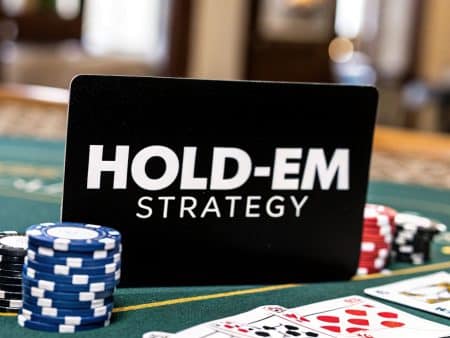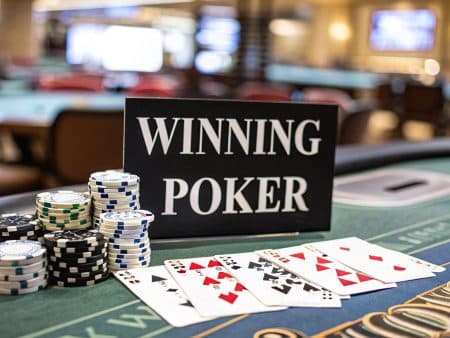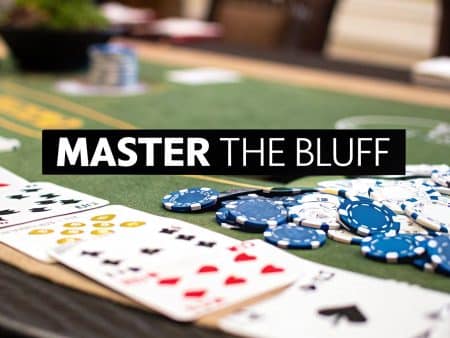Playing heads-up poker is a completely different beast. Forget what you know about a packed nine-player table; this is a pure one-on-one battle where you’re in every single hand. It's a relentless test of skill that demands constant aggression, sharp reads, and the ability to adapt on the fly. You're always either the small blind (and on the button) or the big blind, which completely changes the dynamics of the game.
The Art of the One-on-One Poker Duel
Heads-up poker throws the safety of a crowded table right out the window. You can’t just sit back and wait for pocket aces or kings. If you try that, the blinds will eat your stack alive before you know it. This high-pressure format forces a massive shift in mindset, pushing you away from passive play and demanding controlled aggression.
This is the ultimate training ground for any serious poker player because it forces you to develop a much more dynamic skill set. You’ll quickly learn to:
- Play a wider range of hands: Cards you’d instantly fold in a full-ring game suddenly become playable, even powerful, when it's just you and one opponent.
- Master positional advantage: The button is king. Learning how to exploit it isn't just a good idea—it's absolutely essential for success.
- Read your opponent like a book: With only one person to focus on, you can zero in on their betting patterns, timing tells, and psychological tendencies much faster.
The popularity of heads-up poker exploded during the global poker boom, largely thanks to televised tournaments and the massive growth of online poker sites. In fact, the number of online poker players hit an estimated 100 million globally by 2023, making these one-on-one showdowns more accessible than ever. You can dive deeper into online poker statistics to see just how much the game has grown.
Heads-up poker is a relentless game of adjustments. It’s less about the cards you're dealt and far more about how you play the person sitting across from you. Your ability to adapt your strategy from one hand to the next is what separates winners from losers.
Ultimately, learning to play heads-up poker is about embracing the confrontation. It’s a fast-paced duel where every single decision matters, making it one of the most challenging and rewarding forms of the game you'll ever play.
Rethinking Your Pre-Flop Game for Heads-Up Play
If you’re coming from a full nine-handed table, your old pre-flop strategy is now obsolete. Forget everything you thought you knew. Passively waiting for pocket Aces or Kings is a surefire way to watch your chip stack get devoured by the relentless, back-and-forth blinds. To win at heads-up, you have to adopt a relentlessly aggressive and adaptable pre-flop game.
The entire dynamic boils down to two positions: you’re either on the button (acting as the small blind) or you’re in the big blind. That’s it. This forces you to play a staggering percentage of your hands. From the button, you have the ultimate post-flop advantage, which makes raising with an incredibly wide range of hands—often 70% or more—the correct play.
This isn’t about being reckless. It's about applying constant, calculated pressure. Every time you raise from the button, you force your opponent in the big blind into a tough spot. They have to either surrender their blind or play the rest of the hand out of position, a huge strategic handicap.
The Power of the Button Raise
When you're on the button, your go-to weapon is the pre-flop raise. A standard raise size is usually somewhere between 2.5 and 3 big blinds. This hits the sweet spot—it’s big enough to discourage cheap calls but small enough that you aren't risking a huge chunk of your stack if your opponent fires back with a 3-bet.
Your main goal is to steal the blinds and seize control of the pot. Let's say you're dealt a hand like 9-7 suited on the button. At a full table, that's an instant fold. In a heads-up match? That’s a clear raise. The hand has potential to connect with straights and flushes, and your positional advantage lets you dictate the action after the flop.
The single biggest leak I see in new heads-up players is being too passive from the button. If you're folding more than 30% of your hands from this position, you're just handing your opponent free money without them ever having to play a single card.
To get a better feel for this decision-making process, the chart below breaks down how to categorize your hands and what to do with them.
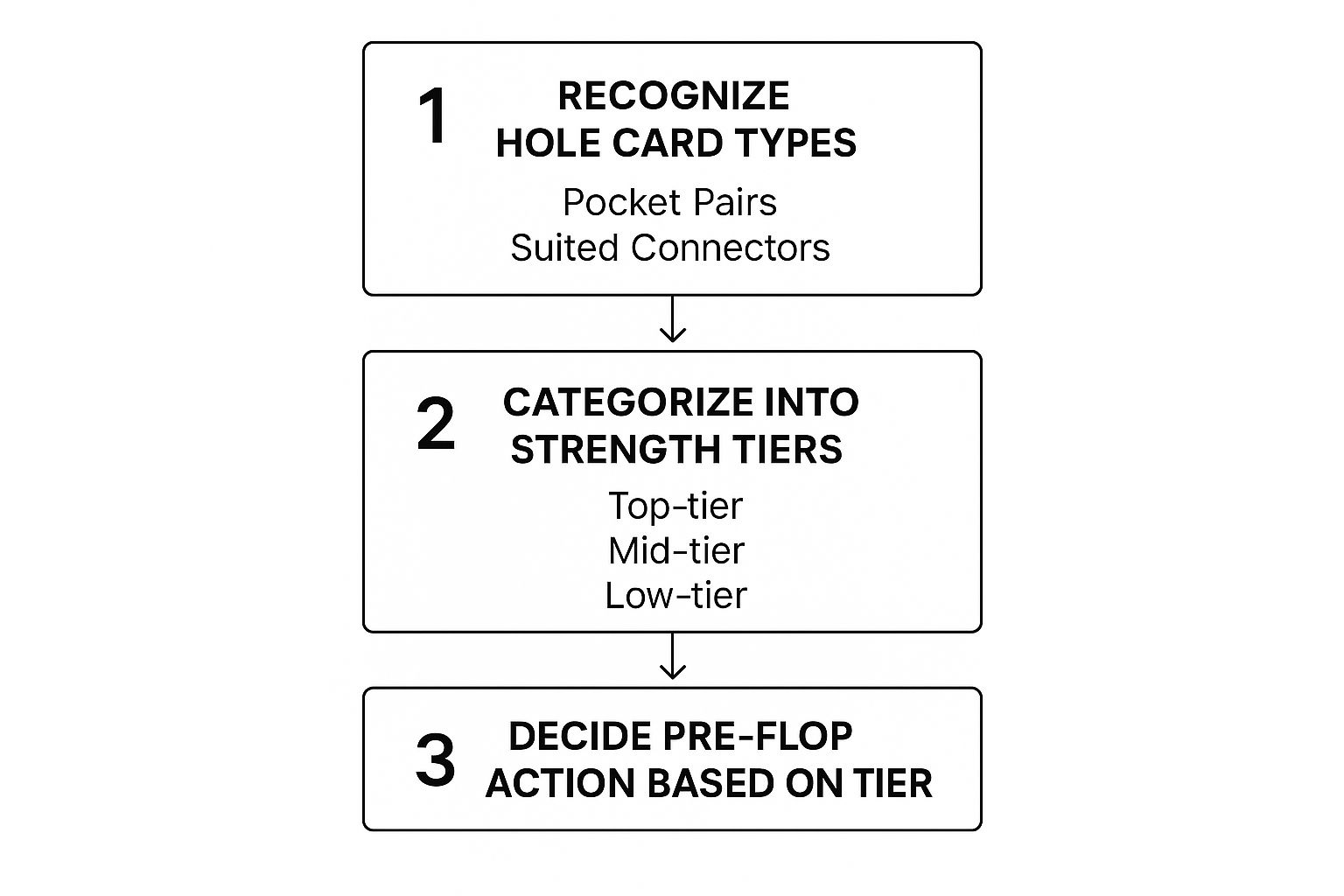
This gives you a simple but powerful framework: identify your hand, assess its strength in a one-on-one context, and then choose an aggressive line. This mindset helps you move away from rigid hand charts and toward a more fluid, opponent-focused strategy.
Defending Your Big Blind Intelligently
While the button is where the power is, playing from the big blind requires a different kind of skill: smart defense. When you’re facing a raise, you need to defend with a wide range of hands, but not just any two cards. Your defense strategy should be a balanced mix of calling and 3-betting. If you want to dive deeper into these core concepts, The Ultimate Guide to Online Poker From Beginner to Pro covers foundational skills that are crucial here as well.
Here’s a look at how to approach your defense:
- 3-Betting for Value: Re-raise with your premium hands (think QQ+, AK) to build a bigger pot when you almost certainly have the best hand.
- 3-Betting as a Bluff: You can't just 3-bet your monsters. You also need to re-raise with some weaker hands, which we call "light" 3-bets. Good candidates are hands like A5-suited or K4-suited. These hands have "blocker" effects—holding an Ace or King makes it less likely your opponent has a premium hand—and can still flop well if you get called.
- Calling to See a Flop: With hands that have good playability, just call. We’re talking about suited connectors (like 8-7 suited), medium pocket pairs, and strong broadway cards (like K-J offsuit). These hands can smash a flop and win a huge pot against an opponent who is raising with a very wide range.
The table below contrasts the aggressive strategy from the button with the defensive approach from the big blind.
Button vs Big Blind Pre-Flop Strategy
| Hand Category | Recommended Button Action | Recommended Big Blind Defense |
|---|---|---|
| Premium Hands (AA-QQ, AK) | Raise 2.5-3x BB. Prepare to 4-bet or go all-in if re-raised. | 3-bet for value to build the pot. |
| Strong Hands (JJ-99, AQ-AJ) | Always raise. This applies pressure and defines your range. | Mix between calling and 3-betting to balance your range. |
| Speculative Hands (Suited Connectors, Gappers) | Raise. Your goal is to take it down pre-flop or win with a big hand post-flop. | Call. These hands play well post-flop, especially in position. |
| Weak Aces/Kings (A2s-A9s, K2s-K9s) | Raise. These have great blocker value and semi-bluffing potential. | 3-bet as a bluff. They block strong hands your opponent might have. |
| Trash/Weak Hands (72o, 94o) | Fold. Even in heads-up, some hands are just unplayable. | Fold. Don't feel forced to defend every single hand. |
Mastering heads-up poker means getting comfortable with this pre-flop dance of aggression and defense. It's a constant battle for control, where your position and the pressure you apply are your most valuable assets.
Winning the Post-Flop Battle from Any Position
The pre-flop raise is just the opening skirmish. The real war in heads-up poker is won and lost on the flop, turn, and river. This is where your read on the opponent and your ability to adapt truly matter. With ranges being so wide, every post-flop decision is amplified, and a single mistake can cost you a huge pot.
A go-to move for many is the continuation bet (c-bet)—betting the flop after you were the one who raised pre-flop. But just blindly firing a c-bet on every single board is a surefire way to bleed chips. Your strategy needs to be way more nuanced, shifting based on who has position and what the board looks like.
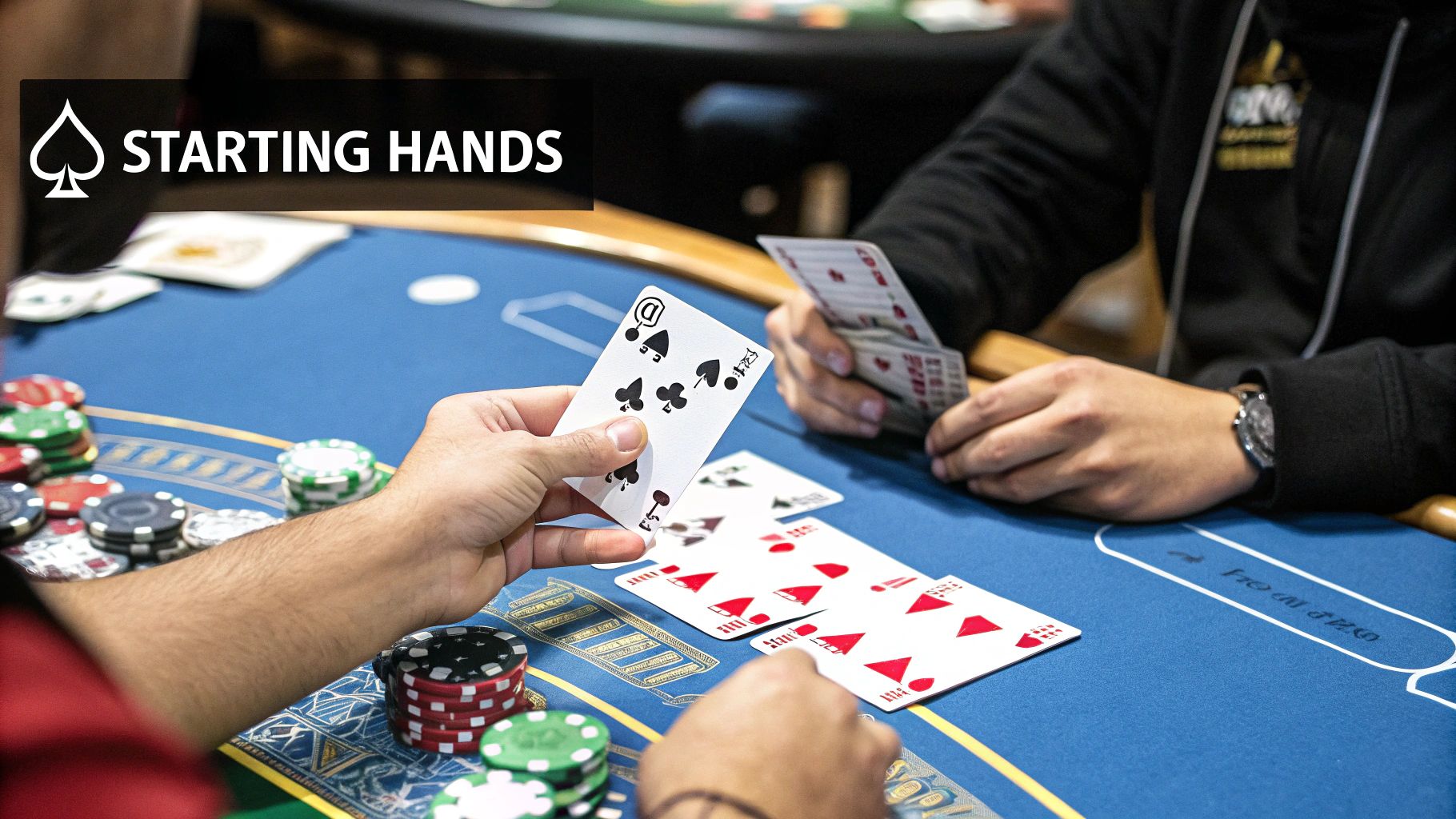
Mastering the Continuation Bet
When you're on the button, you hold all the cards—figuratively speaking. Acting last is a massive advantage because you get to see what your opponent does first.
- Dry, Disconnected Boards: Let's say the flop comes down K♠ 7♦ 2♣. This kind of board is incredibly unlikely to have helped your opponent's wide calling range from the big blind. You should be c-betting here a huge percentage of the time. A small bet, maybe a third of the pot, is often all it takes to scoop it up right there.
- Wet, Coordinated Boards: Now, picture a flop like J♥ 10♥ 9♣. This board is dripping with draws. Trying to bluff with total air here is just asking for trouble, as your opponent is very likely to have connected in some way. On these boards, you should tighten up, betting your big hands for value and semi-bluffing with your own draws.
This selective aggression keeps your opponent completely off-balance. For more on how to apply pressure effectively, checking out some proven online poker strategies can give you a solid framework for post-flop play.
Playing Without Positional Advantage
Let's flip the script. Being out of position in the big blind is arguably the toughest spot in poker. You’re acting first on every street, essentially flying blind. Your best friend here is the check-raise.
A well-timed check-raise is a beautiful thing. It builds a bigger pot when you're strong and can get a better hand to fold when you're bluffing. It's how you seize control of the hand and turn the pressure right back on the player who thought they had it.
Imagine you defend your big blind with 8♠ 7♠. The flop comes K♠ 9♦ 5♠, giving you a flush draw and a gutshot straight draw. The standard play is to check. If your opponent on the button fires a typical c-bet, this is a prime spot to pop them with a check-raise. You put their entire range to the test, and even if you get called, you have a ton of equity to hit your hand on the turn or river.
Firing Multiple Barrels
Winning in heads-up often comes down to telling a convincing story. You can't just bet the flop and give up if you get called. This is where barreling—betting multiple streets—comes in.
Say you raise from the button with A♦ K♦ and get called. The flop is a dry 10♠ 6♣ 2♥. You make a standard c-bet and they call. The turn brings the Q♠. This is a perfect card to fire that second barrel. Why? It’s a scare card for hands like a ten or a six, and it actually improves your hand by giving you a gutshot straight draw to go with your overcards.
When you bet again, you’re telling a story that you have a Queen or a better ten. This relentless, logical pressure is how you force folds and win pots, even when you don't have the nuts.
How to Profile and Exploit Your Opponent
In heads-up poker, the cards you're dealt are almost an afterthought. Your real focus needs to be laser-sharp on the single person sitting across the table. Their habits, their tells, and their emotional state—that's what truly drives the game. Forget just playing your hand; your mission is to play the player.
The first order of business is a quick diagnosis. Are you up against a hyper-aggressive maniac who seems to raise with any two cards? Or is it a passive "calling station" who just wants to see every flop and chase every draw? Figuring this out within the first dozen hands is your top priority.
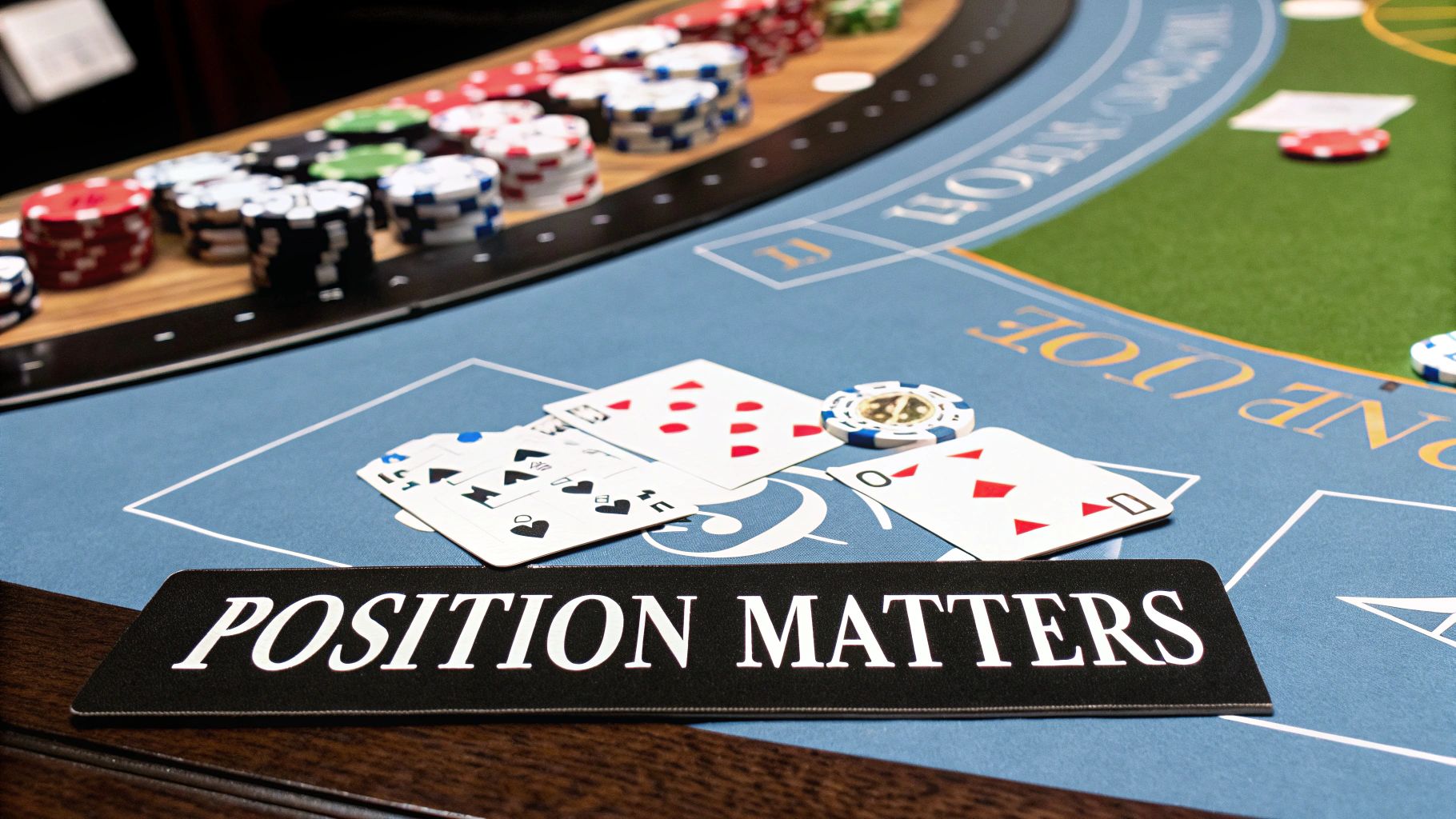
Identifying Player Archetypes
Most players you’ll encounter will fit loosely into a few common profiles. Watch their patterns closely to build a mental picture and start forming a game plan.
- The Maniac: This player lives and breathes aggression. They 3-bet constantly, fire multiple barrels post-flop, and generally try to steamroll you. You’ll notice they almost never fold to a single bet.
- The Calling Station: This is a curious and passive opponent. They rarely raise but will call bets with an incredibly wide—and often weak—range of hands, just hoping to hit something magical by the river.
- The Tight-Passive Player (The Rock): Honestly, this is the rarest type you'll see in heads-up, because it's so easy to exploit. They play very few hands and only show real strength when they've got the nuts. If they bet big, believe them.
Think of these archetypes as a starting point. Your job is to take what they see as their greatest strength and make it their biggest downfall.
Crafting a Counter-Strategy
Once you have a read on your opponent, it's time to adapt. Playing the same style against everyone is a surefire way to go broke.
Your goal isn't to prove you're the better player by out-bluffing a bluffer. Your goal is to find the path of least resistance to their chip stack. Against an aggressive player, that path is trapping. Against a passive player, it's non-stop value betting.
So, how does this look in practice? Against a maniac, your adjustment is simple: become a master trapper. Let them do all the heavy lifting. Instead of re-raising your pocket Kings pre-flop, just call and let them bluff their stack away when you connect with the board.
On the other hand, against a passive calling station, you need to apply relentless pressure. Stop trying to bluff them; it's a waste of chips because they'll call you down with anything. Instead, bet for value every time you have a decent made hand.
The study of game theory offers some incredible insights here. Back in 2015, computer scientists essentially "solved" Heads-Up Limit Hold'em, creating a nearly perfect strategy. While that's for the limit version of the game, the principles behind betting patterns and equilibrium are something elite no-limit players use to sharpen their exploitative plays. You can learn more about these fascinating poker game theory findings.
Observing your opponent's betting patterns and even their physical mannerisms can give you an extra edge. Learning to spot these signals is a powerful skill. To dive deeper, check out our guide on poker tell recognition and the 15 signs your opponent is bluffing. This is how you turn the game from a math problem into a psychological battle you can dominate.
Avoiding the Most Common Heads Up Poker Mistakes
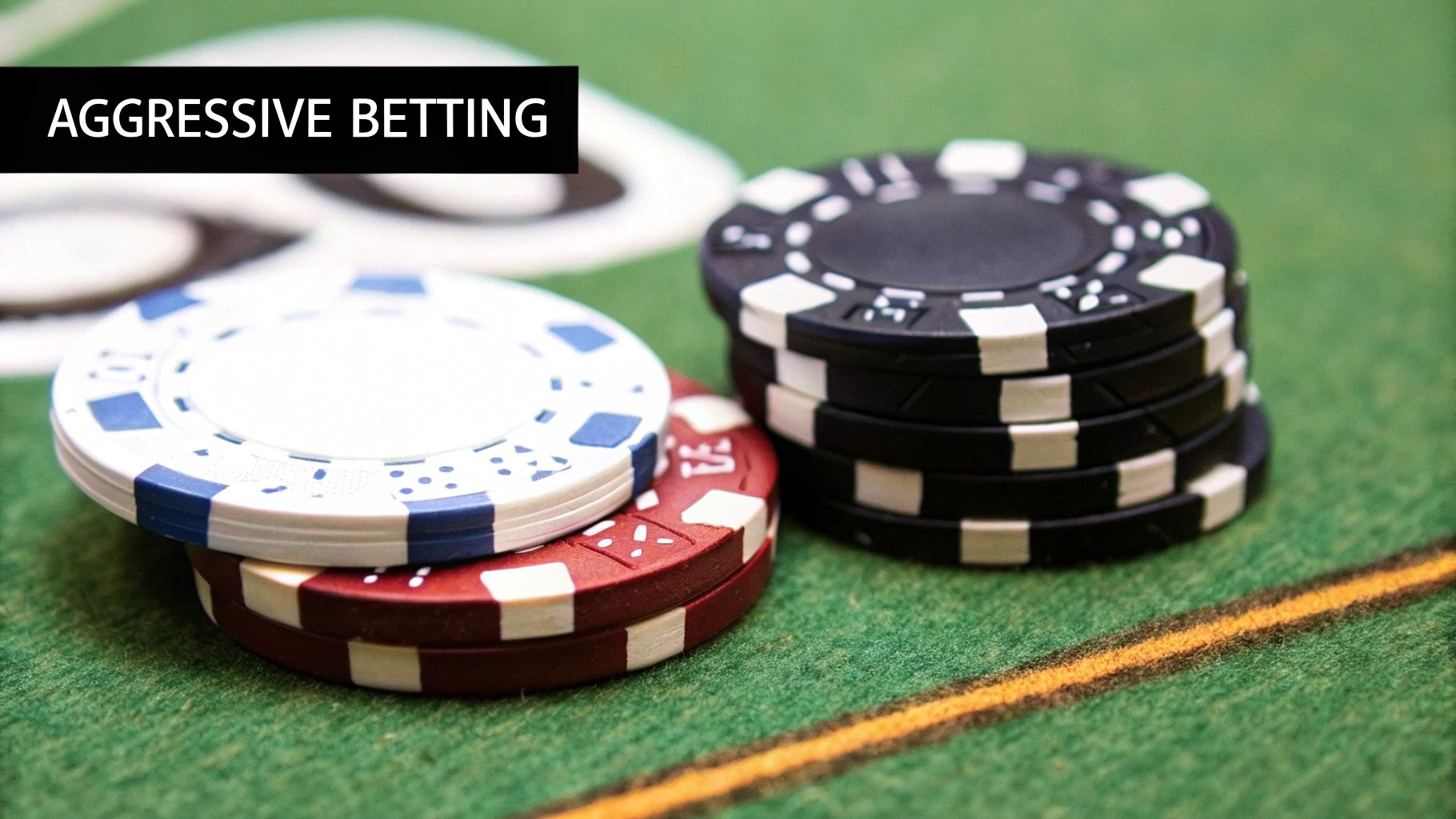
When you're playing one-on-one, every single decision gets magnified. A small leak in your game that you could get away with at a full table suddenly becomes a massive hole, draining your bankroll with alarming speed. To really learn heads-up poker, you have to find and patch these common leaks before they sink you.
So many players fall into a passive trap, especially when they're out of position. They play heads-up poker like it's a nine-handed cash game, and that's a fatal flaw. The biggest mistakes aren't always obvious; they're often subtle habits that feel "safe" but are quietly costing you a fortune.
Playing Too Passively From the Button
This is the big one. The single most damaging mistake you can make is treating the button with too much reverence. When you’re on the button, you are the aggressor, period. Folding hands like K-7 offsuit or 9-6 suited is a huge mistake because you’re giving up the most powerful position at the table without even a fight.
Let's look at a common scenario. You're on the button with Q♦️6♣️ and you just muck it, thinking you'll wait for a better spot.
Instead, you should recognize the massive advantage you have. The correct play is to raise to 2.5 big blinds. This immediately puts your opponent in a tough spot. They're out of position and have to make a decision for their entire stack. More often than not, they’ll just fold, and you'll pick up the blinds for free.
The button is where you make your money in heads-up play. If you aren't raising at least 70% of your buttons, you are handing your opponent a massive, unearned edge. Aggression from this position isn't just an option; it's the foundation of a winning strategy.
Getting Married to Medium-Strength Hands
In heads-up, hand ranges are incredibly wide. A hand like top pair with a weak kicker can feel like the nuts. The problem is, getting too attached to these marginal hands is a fast track to losing huge pots. You have to be ready to make tough folds when you face real aggression.
Imagine you hold K♠️5♠️ and the flop comes down K♣️9♦️2♥. Hitting top pair feels great, but your kicker is garbage. If your opponent starts check-raising and then fires again on the turn, your hand shrinks from a hero to a zero. Calling down here is usually a losing play against a thinking, aggressive opponent who is representing a better King or even a set. Understanding the push and pull of these moments is critical, which involves knowing when to apply pressure yourself. It's worth your time to get better at refining poker bluff strategies to navigate these tricky spots.
Letting Tilt Control Your Decisions
Heads-up poker is an emotional minefield. The swings are wild and fast, and a couple of bad beats can easily send you "on tilt," where frustration and anger start making your decisions for you.
When tilt takes over, you'll start doing things like:
- Playing way too aggressively: Trying to force wins and get your money back with bone-headed bluffs.
- Playing way too passively: Getting scared, tightening up, and folding hands you know you should be playing.
The first step is just recognizing the signs. If you feel your heart pounding and your judgment clouding over, you have to step away from the table. Take a five-minute break. Protecting your mental game is just as important as protecting your chips.
Frequently Asked Questions About Heads Up Poker
Even after you've got the basics down, heads-up poker can still throw some curveballs. Let's tackle some of the most common questions that pop up once players start grinding it out one-on-one. This should help clear up any confusion and get your game on solid ground.
What Is a Good Starting Hand in Heads Up Poker?
This is the first mental hurdle for most players. The truth is, the idea of a "good" hand completely changes. In a one-on-one game, your position is miles more important than your specific two cards. If you're waiting around for pocket aces or kings, you're going to get run over.
When you're on the button, you're the aggressor. You should be raising an incredibly wide range of hands—often 70% or more—to keep the pressure on. Hands you'd instantly muck in a full-ring game, like K-7 offsuit or 9-6 suited, are now standard raises.
From the big blind, you're defending. Your range here needs to be wide too, but a bit more thoughtful. You'll want to call with hands that have potential, like suited connectors, gappers, and any pair.
The real shift in thinking is from "what are my cards?" to "what is my position?". Your edge in heads-up comes from relentless aggression and leveraging your position, not from waiting for premium cards.
How Do I Handle a Very Aggressive Opponent?
Running into a hyper-aggressive player—a "maniac"—can be intimidating. The key is to completely flip the script. Don't try to out-bluff them or get into an ego-driven raising war. That’s playing their game. Your new job is to become a trapper and use their own aggression against them.
Let the maniac do all the heavy lifting for you by building the pot. When you look down at a monster hand like pocket queens or A-K, your instinct might be to 3-bet. Resist it. Just flat-call pre-flop to keep their entire range of weaker hands in the pot. You want them to feel like they're in control.
Post-flop is where you spring the trap. Look for spots to check-raise when they make their predictable continuation bet. Your greatest weapon against a maniac isn't your own aggression; it's patience. Wait for a big hand, and then let them do what they do best: bluff their stack right into you.
How Important Is Bankroll Management in Heads Up?
It's everything. I'd argue it’s more critical in heads-up than in any other poker format. The variance is just on another level. Because you're playing every single hand, the financial swings are wild and fast.
A solid rule of thumb is to have a minimum of 50 buy-ins for the stakes you're playing. So, if you're battling it out in $50 heads-up matches, you really need a bankroll of at least $2,500.
This isn't just about the money; it's about your mental state. A deep bankroll gives you a cushion to ride out the inevitable downswings without letting fear creep into your decisions. Understanding the mental game is a huge part of this, which you can read more about in this guide to the psychology of bluffing and applying real-world tells. That financial security is what allows you to play your A-game, even when the cards aren't falling your way.
At PokerSites.org, we're dedicated to helping you sharpen your skills. Find in-depth reviews, expert strategies, and the best poker site bonuses to elevate your game at https://www.pokersites.org.
Article created using Outrank
